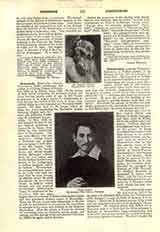

Domenichino, properly DOMENICO ZAMPIERI, an Italian painter, b. in Bologna, October 21, 1581; d. in Naples, April 16, 1641. He began his art studies in the school of Calvaert, but being ill-treated there, his father, a poor shoe-maker, placed him in the Carracci Academy, where Guido Reni and Albani were also students. Domenichino was a slow, thoughtful, plodding youth whom his companions called the “Ox”, a nickname also borne by his master Ludovico. He took the prize for drawing in the Carracci Academy, gaining thereby both fame and hatred. Stimulated by success, he studied unremittingly, particularly the expression of the human face, so that Bellori says “he could delineate the soul”.
His student days over, he first visited Parma and Modena to study Correggio, and then went to Rome, where his earliest friend and patron, Cardinal Agucchi, commissioned him to decorate his palace. In Rome he assisted the Carracci with their frescoes in the palace of Cardinal Farnese, who became such an admirer of Domenichino that he had him execute many of the pictures in the Basilian Abbey of Grotta Ferrata. Domenichino’s best frescoes are in this church. With Guido he painted, for Cardinal Borghese, in S. Gregorio; for Cardinal Aldorandini he executed ten frescoes at Villa Frascati; for Cardinal Montalto he decorated S. Andrea della Valle; and for Cardinal Bandini he painted four pictures for S. Silvestro which rank among his best productions.
He immortalized his name by painting (1614) for the altar of S. Girolamo della Carita, the “Communion of St. Jerome”, a copy of which, in mosaics, is in St. Peter’s. This is one of the great pictures of the world and was considered second only to Raphael‘s “Transfiguration“. He received about fifty dollars for it. Napoleon took it to Paris but the Allies returned it. Jealousy of Domenichino long accumulating now burst forth, and he was accused of copying his masterpiece from Agostino Carracci. Weary of attacks, the artist went to Bologna but later returned to Rome, where Pope Gregory XV made him painter and architect of the Apostolic Camera (pontifical treasury). In 1630 he settled in Naples and there opened a school, but was harassed, as in Rome, by envious artists (cabal of Naples), who disfigured his paintings. Mental suffering, perhaps poison, hastened his death. Domenichino, although not a master of great originality and inspiration, was a prominent figure in the Bolognese School. Potent in fresco he also excelled in decorative landscapes; his color was warm and harmonious, his style simple, his chiaroscuro superbly managed, and his subordinate groups and accessaries well adjusted and of great interest. The most famous masters of the burin engraved his works, which are: “Portrait of Cardinal Agucchi”, Uffizi, Florence; “Life of St. Nilus” (fresco) in Grotta Ferrata near Rome; “Condemnation of Adam and Eve“, Louvre, Paris; “St. George and the Dragon”, National Gallery, London; “St. John”, Hermitage, St. Petersburg.
LEIGH HUNT

